Report: Social and Emotional Development of Young Deafblind Children
VerifiedAdded on 2023/01/05
|6
|898
|46
Report
AI Summary
This report focuses on the social and emotional development of young deafblind children, specifically those aged 3 to 5. It emphasizes that social development in these children relies heavily on sensory input, particularly touch, and vision. The report outlines key developmental areas, including self-reliance, empathy, and sensory-motor skills, alongside potential red flags in social-emotional development such as dependence on caregivers and sensory impairments. It underscores the critical role of caregivers in fostering secure attachments, promoting independence, and supporting positive behaviors through creating playful environments, encouraging independence, and fostering emotional responses. The report references key studies that support the development of children with deafblindness.
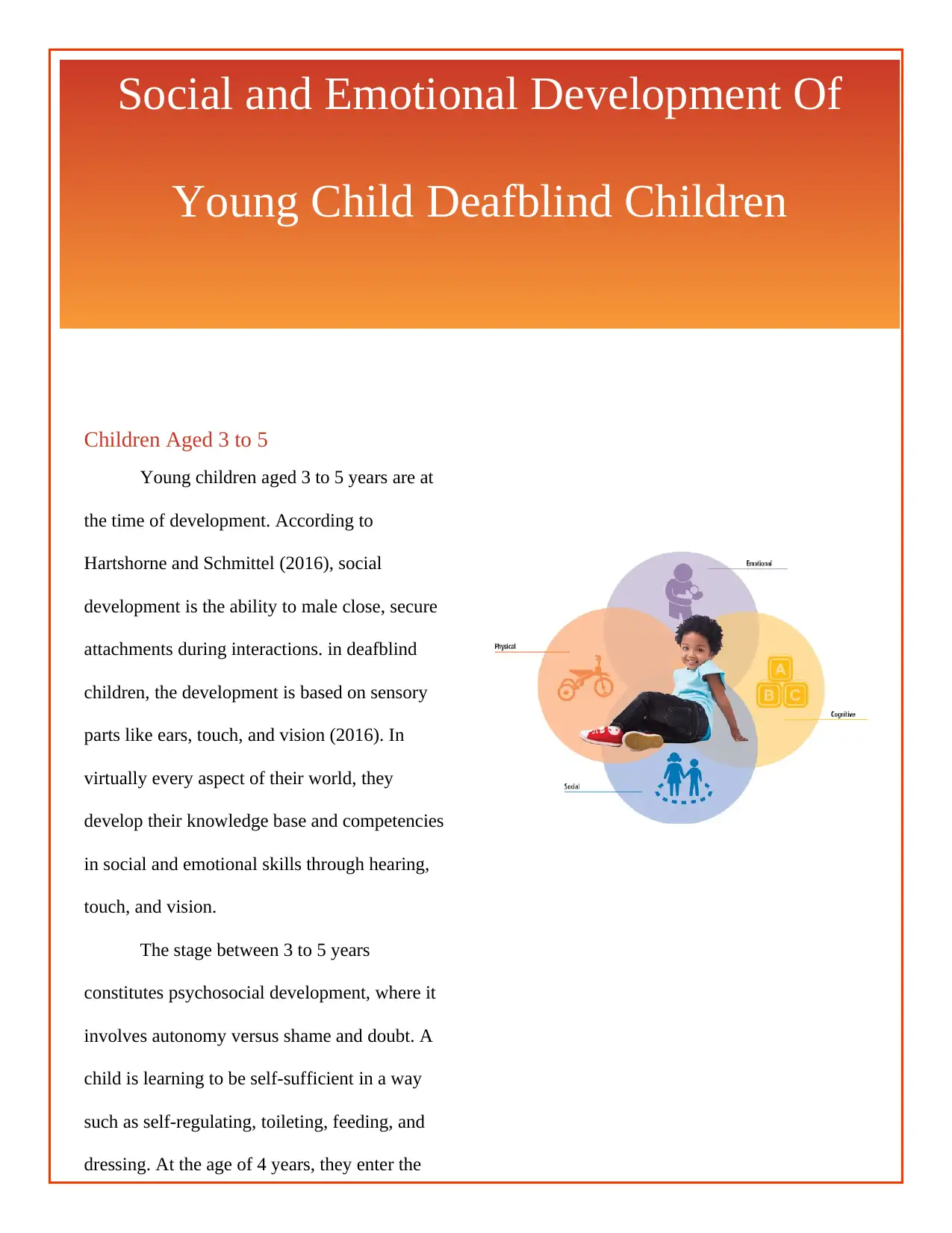
Children Aged 3 to 5
Young children aged 3 to 5 years are at
the time of development. According to
Hartshorne and Schmittel (2016), social
development is the ability to male close, secure
attachments during interactions. in deafblind
children, the development is based on sensory
parts like ears, touch, and vision (2016). In
virtually every aspect of their world, they
develop their knowledge base and competencies
in social and emotional skills through hearing,
touch, and vision.
The stage between 3 to 5 years
constitutes psychosocial development, where it
involves autonomy versus shame and doubt. A
child is learning to be self-sufficient in a way
such as self-regulating, toileting, feeding, and
dressing. At the age of 4 years, they enter the
Social and Emotional Development Of
Young Child Deafblind Children
Young children aged 3 to 5 years are at
the time of development. According to
Hartshorne and Schmittel (2016), social
development is the ability to male close, secure
attachments during interactions. in deafblind
children, the development is based on sensory
parts like ears, touch, and vision (2016). In
virtually every aspect of their world, they
develop their knowledge base and competencies
in social and emotional skills through hearing,
touch, and vision.
The stage between 3 to 5 years
constitutes psychosocial development, where it
involves autonomy versus shame and doubt. A
child is learning to be self-sufficient in a way
such as self-regulating, toileting, feeding, and
dressing. At the age of 4 years, they enter the
Social and Emotional Development Of
Young Child Deafblind Children
Paraphrase This Document
Need a fresh take? Get an instant paraphrase of this document with our AI Paraphraser
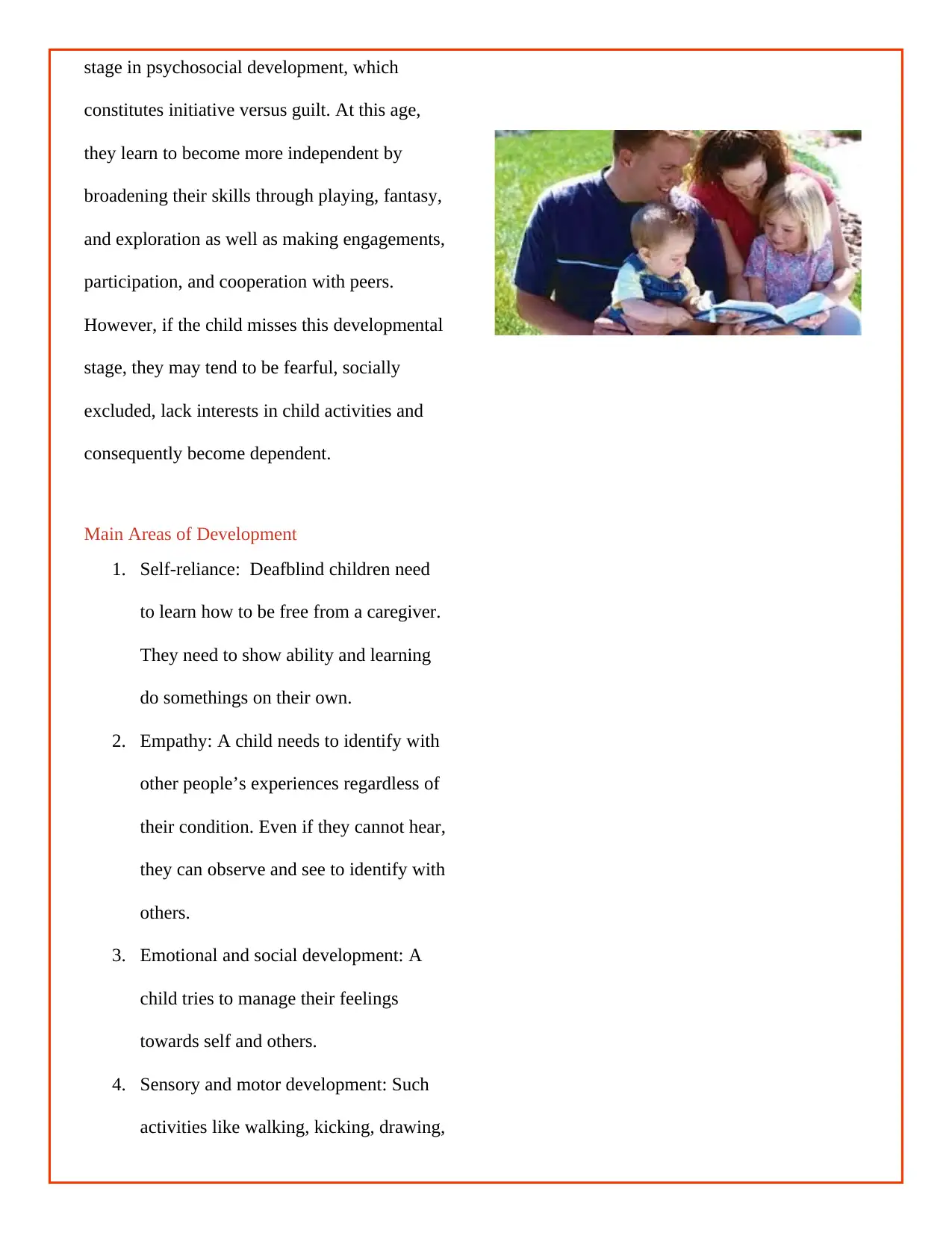
stage in psychosocial development, which
constitutes initiative versus guilt. At this age,
they learn to become more independent by
broadening their skills through playing, fantasy,
and exploration as well as making engagements,
participation, and cooperation with peers.
However, if the child misses this developmental
stage, they may tend to be fearful, socially
excluded, lack interests in child activities and
consequently become dependent.
Main Areas of Development
1. Self-reliance: Deafblind children need
to learn how to be free from a caregiver.
They need to show ability and learning
do somethings on their own.
2. Empathy: A child needs to identify with
other people’s experiences regardless of
their condition. Even if they cannot hear,
they can observe and see to identify with
others.
3. Emotional and social development: A
child tries to manage their feelings
towards self and others.
4. Sensory and motor development: Such
activities like walking, kicking, drawing,
constitutes initiative versus guilt. At this age,
they learn to become more independent by
broadening their skills through playing, fantasy,
and exploration as well as making engagements,
participation, and cooperation with peers.
However, if the child misses this developmental
stage, they may tend to be fearful, socially
excluded, lack interests in child activities and
consequently become dependent.
Main Areas of Development
1. Self-reliance: Deafblind children need
to learn how to be free from a caregiver.
They need to show ability and learning
do somethings on their own.
2. Empathy: A child needs to identify with
other people’s experiences regardless of
their condition. Even if they cannot hear,
they can observe and see to identify with
others.
3. Emotional and social development: A
child tries to manage their feelings
towards self and others.
4. Sensory and motor development: Such
activities like walking, kicking, drawing,
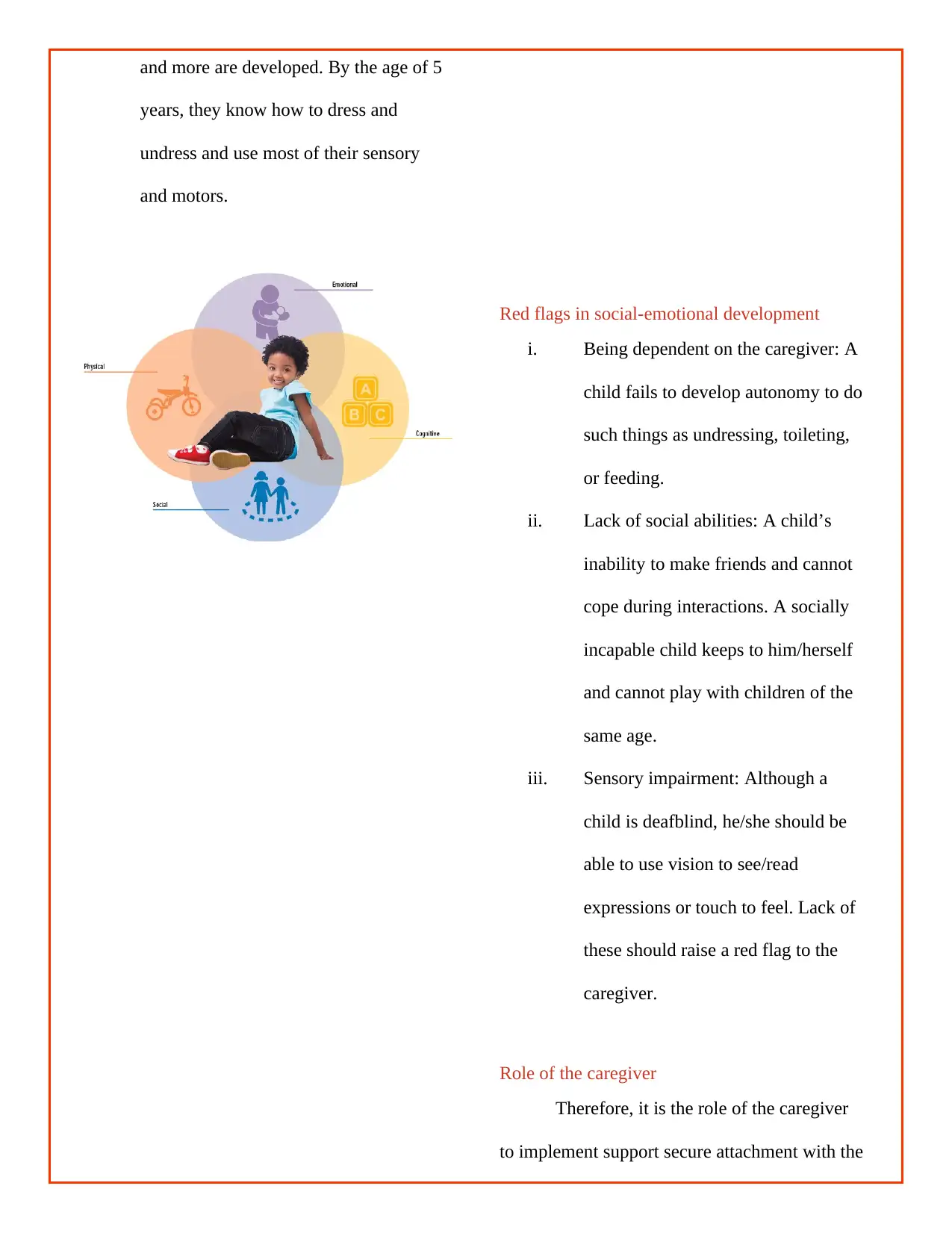
and more are developed. By the age of 5
years, they know how to dress and
undress and use most of their sensory
and motors.
Red flags in social-emotional development
i. Being dependent on the caregiver: A
child fails to develop autonomy to do
such things as undressing, toileting,
or feeding.
ii. Lack of social abilities: A child’s
inability to make friends and cannot
cope during interactions. A socially
incapable child keeps to him/herself
and cannot play with children of the
same age.
iii. Sensory impairment: Although a
child is deafblind, he/she should be
able to use vision to see/read
expressions or touch to feel. Lack of
these should raise a red flag to the
caregiver.
Role of the caregiver
Therefore, it is the role of the caregiver
to implement support secure attachment with the
years, they know how to dress and
undress and use most of their sensory
and motors.
Red flags in social-emotional development
i. Being dependent on the caregiver: A
child fails to develop autonomy to do
such things as undressing, toileting,
or feeding.
ii. Lack of social abilities: A child’s
inability to make friends and cannot
cope during interactions. A socially
incapable child keeps to him/herself
and cannot play with children of the
same age.
iii. Sensory impairment: Although a
child is deafblind, he/she should be
able to use vision to see/read
expressions or touch to feel. Lack of
these should raise a red flag to the
caregiver.
Role of the caregiver
Therefore, it is the role of the caregiver
to implement support secure attachment with the
⊘ This is a preview!⊘
Do you want full access?
Subscribe today to unlock all pages.

Trusted by 1+ million students worldwide
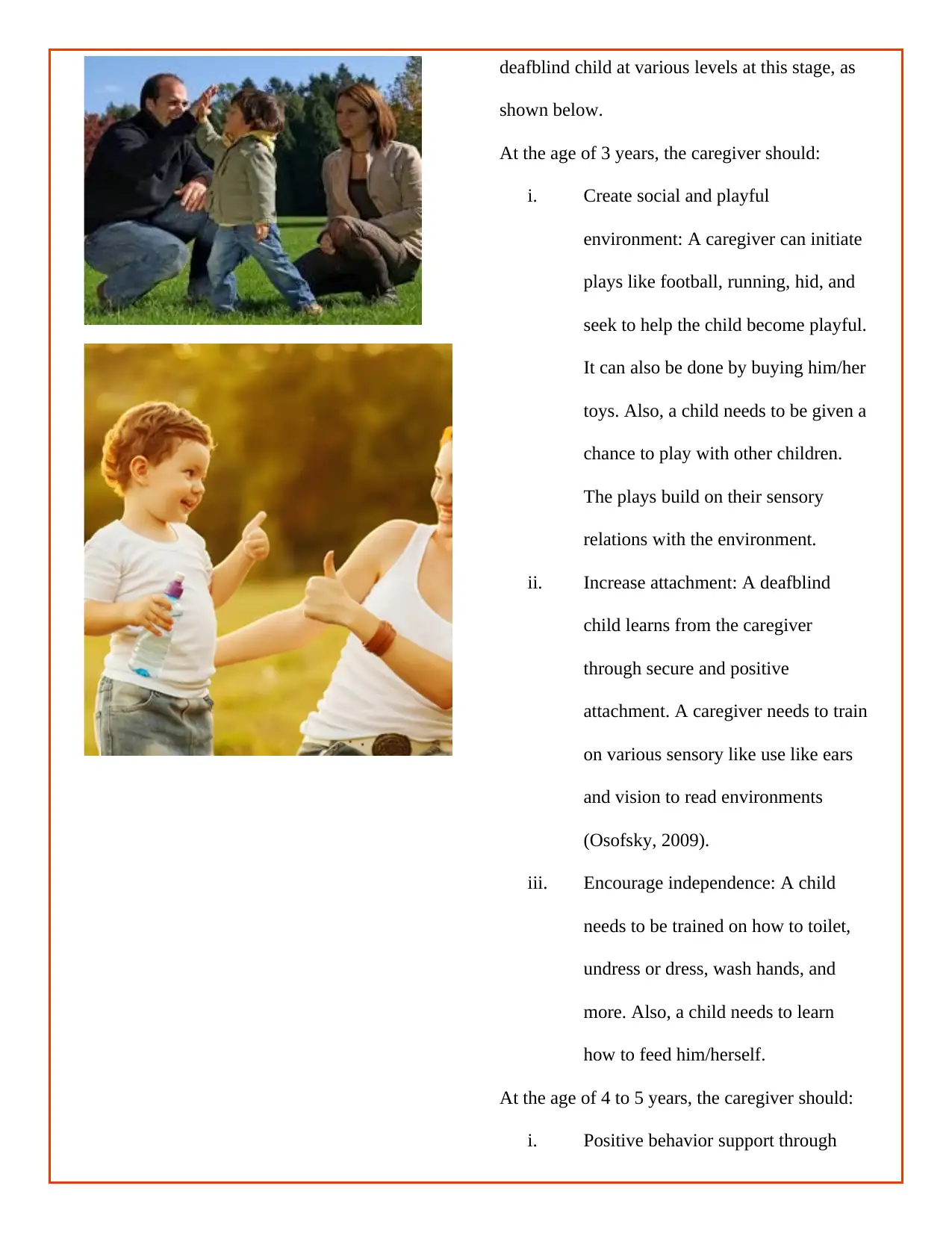
deafblind child at various levels at this stage, as
shown below.
At the age of 3 years, the caregiver should:
i. Create social and playful
environment: A caregiver can initiate
plays like football, running, hid, and
seek to help the child become playful.
It can also be done by buying him/her
toys. Also, a child needs to be given a
chance to play with other children.
The plays build on their sensory
relations with the environment.
ii. Increase attachment: A deafblind
child learns from the caregiver
through secure and positive
attachment. A caregiver needs to train
on various sensory like use like ears
and vision to read environments
(Osofsky, 2009).
iii. Encourage independence: A child
needs to be trained on how to toilet,
undress or dress, wash hands, and
more. Also, a child needs to learn
how to feed him/herself.
At the age of 4 to 5 years, the caregiver should:
i. Positive behavior support through
shown below.
At the age of 3 years, the caregiver should:
i. Create social and playful
environment: A caregiver can initiate
plays like football, running, hid, and
seek to help the child become playful.
It can also be done by buying him/her
toys. Also, a child needs to be given a
chance to play with other children.
The plays build on their sensory
relations with the environment.
ii. Increase attachment: A deafblind
child learns from the caregiver
through secure and positive
attachment. A caregiver needs to train
on various sensory like use like ears
and vision to read environments
(Osofsky, 2009).
iii. Encourage independence: A child
needs to be trained on how to toilet,
undress or dress, wash hands, and
more. Also, a child needs to learn
how to feed him/herself.
At the age of 4 to 5 years, the caregiver should:
i. Positive behavior support through
Paraphrase This Document
Need a fresh take? Get an instant paraphrase of this document with our AI Paraphraser
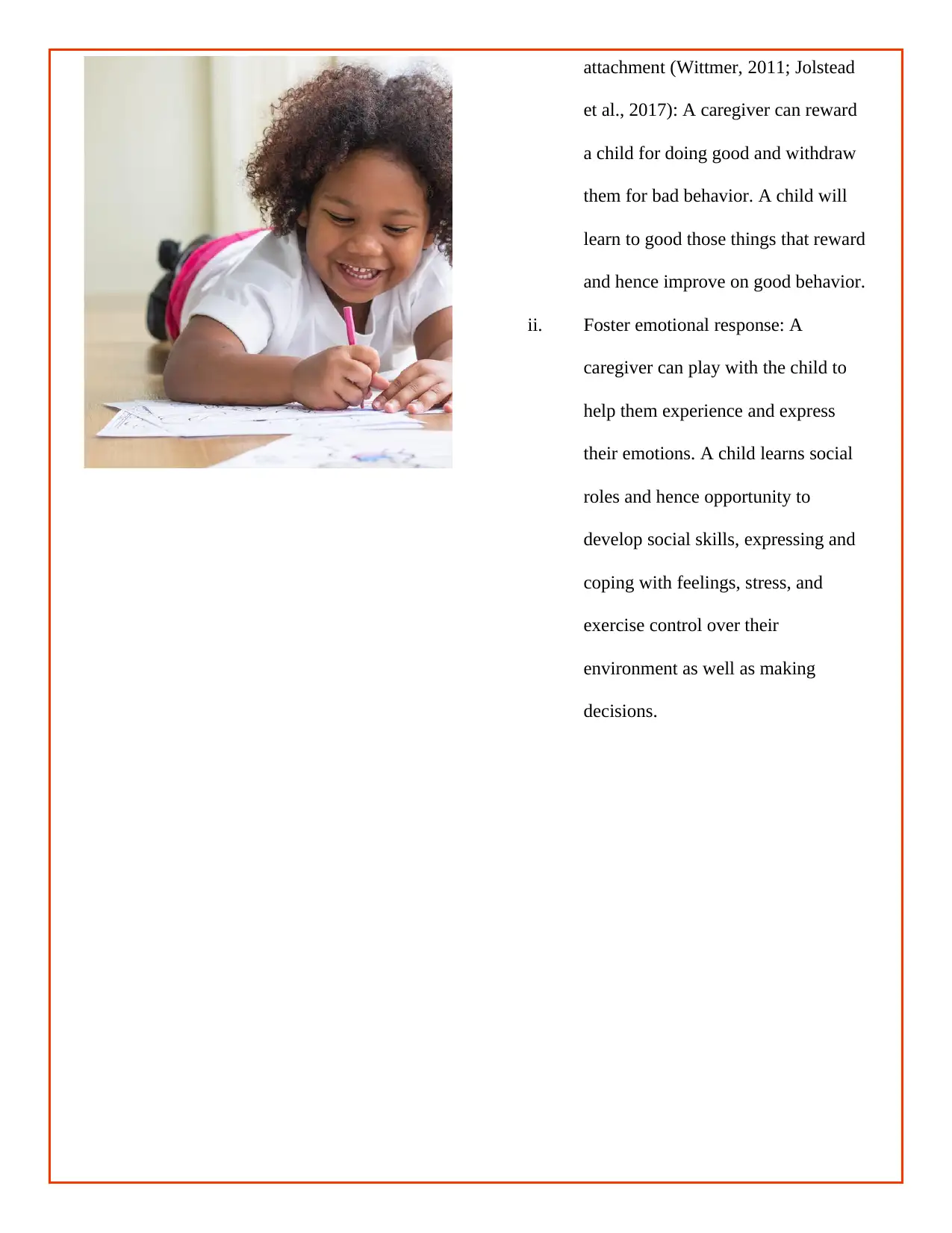
attachment (Wittmer, 2011; Jolstead
et al., 2017): A caregiver can reward
a child for doing good and withdraw
them for bad behavior. A child will
learn to good those things that reward
and hence improve on good behavior.
ii. Foster emotional response: A
caregiver can play with the child to
help them experience and express
their emotions. A child learns social
roles and hence opportunity to
develop social skills, expressing and
coping with feelings, stress, and
exercise control over their
environment as well as making
decisions.
et al., 2017): A caregiver can reward
a child for doing good and withdraw
them for bad behavior. A child will
learn to good those things that reward
and hence improve on good behavior.
ii. Foster emotional response: A
caregiver can play with the child to
help them experience and express
their emotions. A child learns social
roles and hence opportunity to
develop social skills, expressing and
coping with feelings, stress, and
exercise control over their
environment as well as making
decisions.
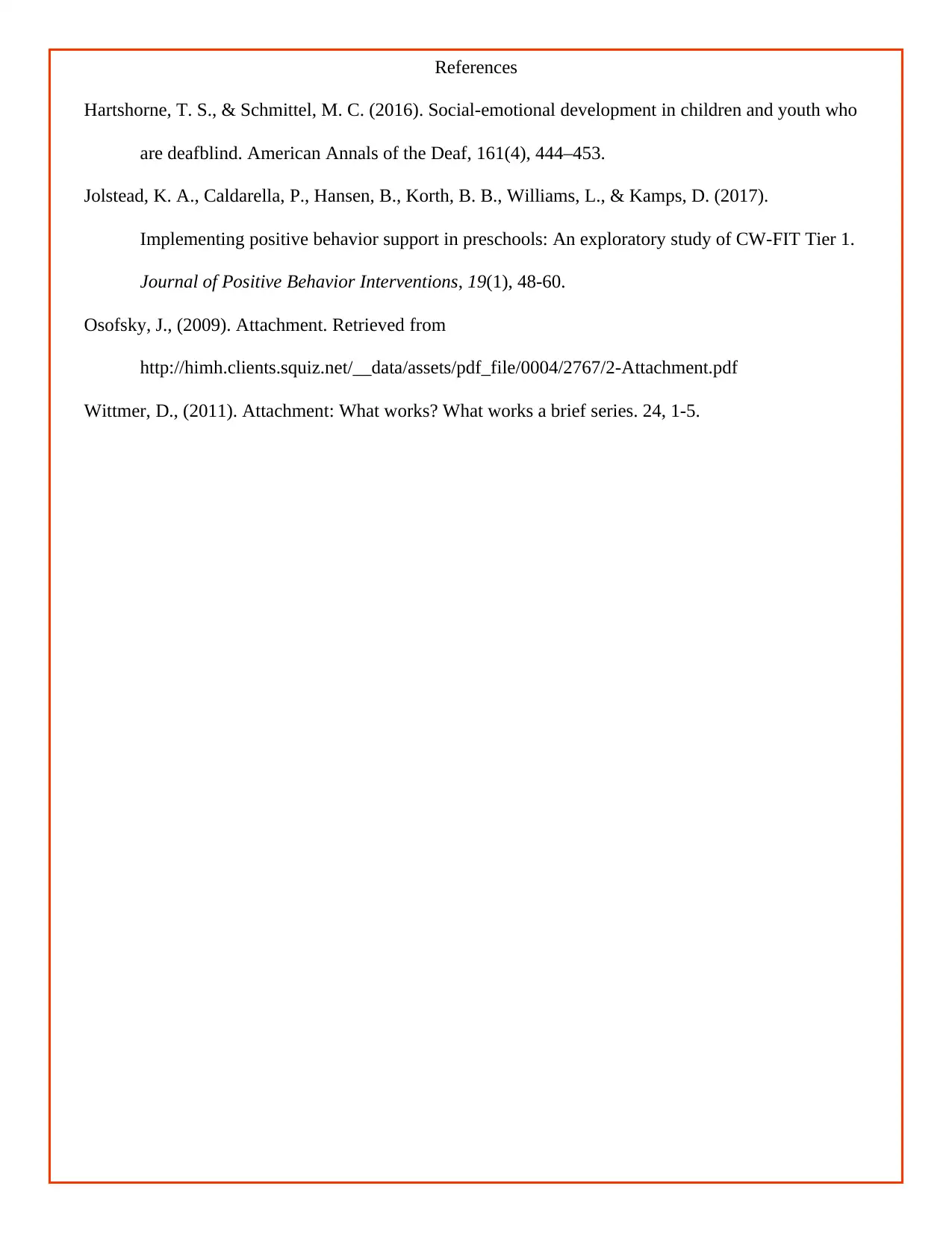
References
Hartshorne, T. S., & Schmittel, M. C. (2016). Social-emotional development in children and youth who
are deafblind. American Annals of the Deaf, 161(4), 444–453.
Jolstead, K. A., Caldarella, P., Hansen, B., Korth, B. B., Williams, L., & Kamps, D. (2017).
Implementing positive behavior support in preschools: An exploratory study of CW-FIT Tier 1.
Journal of Positive Behavior Interventions, 19(1), 48-60.
Osofsky, J., (2009). Attachment. Retrieved from
http://himh.clients.squiz.net/__data/assets/pdf_file/0004/2767/2-Attachment.pdf
Wittmer, D., (2011). Attachment: What works? What works a brief series. 24, 1-5.
Hartshorne, T. S., & Schmittel, M. C. (2016). Social-emotional development in children and youth who
are deafblind. American Annals of the Deaf, 161(4), 444–453.
Jolstead, K. A., Caldarella, P., Hansen, B., Korth, B. B., Williams, L., & Kamps, D. (2017).
Implementing positive behavior support in preschools: An exploratory study of CW-FIT Tier 1.
Journal of Positive Behavior Interventions, 19(1), 48-60.
Osofsky, J., (2009). Attachment. Retrieved from
http://himh.clients.squiz.net/__data/assets/pdf_file/0004/2767/2-Attachment.pdf
Wittmer, D., (2011). Attachment: What works? What works a brief series. 24, 1-5.
⊘ This is a preview!⊘
Do you want full access?
Subscribe today to unlock all pages.

Trusted by 1+ million students worldwide
1 out of 6
Related Documents
Your All-in-One AI-Powered Toolkit for Academic Success.
+13062052269
info@desklib.com
Available 24*7 on WhatsApp / Email
![[object Object]](/_next/static/media/star-bottom.7253800d.svg)
Unlock your academic potential
Copyright © 2020–2025 A2Z Services. All Rights Reserved. Developed and managed by ZUCOL.





